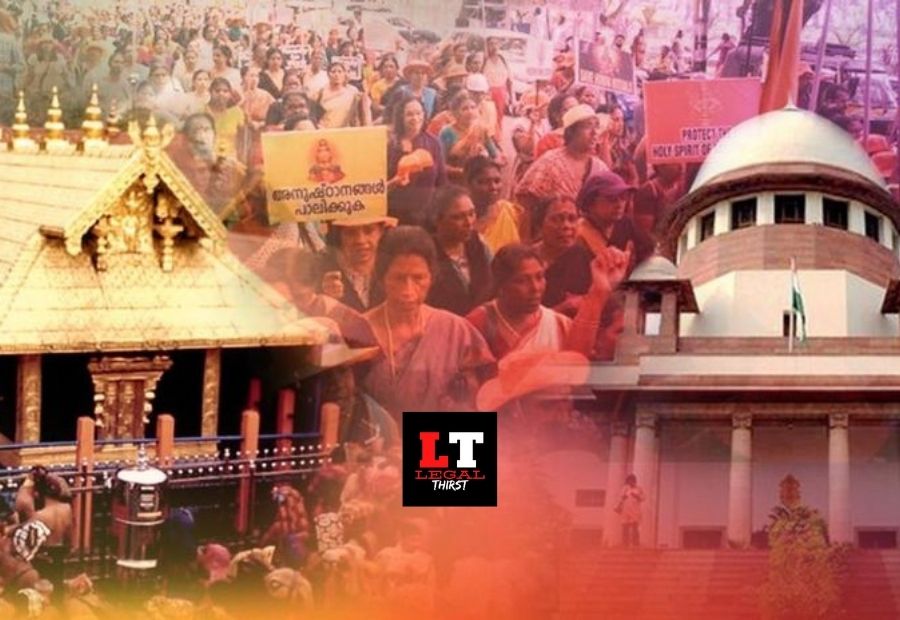This Case Review on ‘SABARIMALA Temple’ is written by Ms. Simran, Student of Law at Mody University. You can reach her at shaffyindia@gmail.com, for any Feedback & Review.
Table of Contents
Case Name: Indian Young Lawyers Association & Ors vs. The State of Kerala & Ors.
Citation: Writ Petition(Civil) No 373 of 2006
Petitioners
Parties name: Indian Young Lawyers Association
Respondents
- Travancore Devaswom Board
- State of Kerala
- Pandalam Royal Family
- Chief Thanthri
Bench: Deepak Mishra, A.N. Khanwilkar, Rohintan Nariman, Indu Malhotra, D.Y. Chandrachud
SABARIMALA Case Review
Sabarimala Temple, devoted to Lord Ayyappa, is a temple of great antiquity. The temple is situated over one of the eighteen mountains spread over the Western Ghats known as Sannidhanam.
The practice of prohibiting the entry of women and barring their participation in the 41 days penance ‘vratham’ has been observed by the Ayyapan community since time immemorial as claimed by the Thantri of the temple. The deity at Sabarimala takes the form of a Naishtika Brahmacharya. Along with observing a penance, the followers are supposed to wear black clothes and cut all family ties while observing the ‘vratham’. It is claimed that a deviation from the celibacy and austerity observed by the followers would be caused by the presence of women. Women have not been allowed to be a part of this pilgrimage due to their physiological features, considering them weak and unfit for the arduous journey. Women are also considered to be impure while menstruating according to Hindu traditions and therefore the temple authorities have placed restrictions on the entry of women between the ages of 10 and 50 to preserve the temple’s sanctity.
In 1990, S Mahendran filed a plea in Kerala High Court seeking a ban on women’s exclusion of entry to the temple. But, Kerala High Court upheld the age-old restriction on women of a certain age-group entering the temple. On August 4, 2006, the Indian Young Lawyers Association filed a plea in the Supreme Court seeking to ensure entry of female devotees between the age group of 10 to 50 at the Lord Ayyappa Temple at Sabarimala.
On September 28, 2018, the Supreme Court passed a verdict that allows entry of women in Sabarimala temple. This judgment addressed various issues before coming to this verdict.
The major issues for which the petitioner contended were:
- Prohibition on women based on biological factors violates Article 14 (Right to equality), Article 15, (prohibition of discrimination), Article 17(untouchability), and any such practice which is actually violative of other mentioned rights cannot be protected by “morality” under Article 25 (freedom to practice and propagation of religion).
- Does the practice of not including women constitute an “essential religious practice” under Article 25 and can a religious institution claim that it comes under the umbrella of the right to manage its own affairs in the matters of religion?
- Whether Ayyappa Temple has a denominational character and, if so, is it permissible on the part of a ‘religious denomination’ managed by a statutory board and financed under Article 290-A of the Constitution of India out of the Consolidated Fund of Kerala and Tamil Nadu to indulge in such practices violating constitutional principles/ morality embedded in Articles 14, 15(3), 39(a) and 51-A (e)?
- Does Rule 3 of the Kerala Hindu Places of Public Worship (Authorisation of Entry) Rules permits ‘religious denomination’ to ban entry of women between the ages of 10 to 50 years? Or if it does then is it a violation of Article 14 and 15(1) of the constitution by prohibiting entry of women on the ground of sex?
Petitioners Arguments
The main arguments contended on Petitioner’s behalf were:
It was stated that not allowing women to worship in the temple does not form an essential part of Hindu religion.
Sabarimala is managed by Travancore Devaswom Board which receives public funds, hence it cannot be deemed as separate religious domination. For this court cited the “Shirur Mutt case”, in which prerequisites for a religious denomination are given.
These are:
- Having its own property
- Having its distinct identity
- Having its own set of followers
- Having its own set of beliefs and practices
- Having its own hierarchy of administration with no outside interference and control
These criteria is not fulfilled here completely, hence it can’t be a religious denomination in itself.
- It was also argued that it was believed and there is evidence of women being allowed at the Temple during the time of Travancore king, so it cannot be deemed as a customary practice running since time immemorial.
- It was contended on behalf of petitioners that instead of religious contentions the ban was based more on the basis of certain practical physiological dimensions like the inability of women to pass a difficult path of forests and mountains over a period of 41 days arduous journey. These reasons are preposterous.
- It was also argued that considering women impure because they menstruate and they can’t be touched at that time is discrimination against them on the basis of their sex and practicing untouchability which is strictly forbidden under our Fundamental Rights.
- Also, Article 25 gives women the freedom to practice their religion too.
- Restriction of women because of the celibate character of the lord Ayappa is demeaning to the women.
- Rule 3 laid down by the Kerala Hindu Places of Public Worship (Authorisation of Entry) Rules is violative of Fundamental Rights.
Respondent’s Arguments
- These restrictions can’t be challenged as they are on the basis of religion and traditions of the deity of the temple.
- It was argued that Lord Ayappa in the temple is celibate and should be treated as a person. And as a person, Lord Ayappa’s Right to Privacy under Article 21 should be protected.
- It was argued that the entry of women of the age 10-50 years of age, which is their menstruating age, is in contrast with the celibate nature of the Lord Ayappa.
- It was also contended that it is not physiologically possible for women to seek 41-day penance.
- It was contended that this prohibition is the very crux of their belief and forms an essential part of this religion.
- It was also contended by them that Article 15(2) is not applied to religious institutions.
JUDGEMENT
Dissenting Views of Justice DY Chandrachud
Justice DY Chandrachud in his judgment stated that restricting only women from the right to worship signifies the subordination of women. He further comments that the exclusionary practice which is based on ‘physiological factors’ that are non-religious in nature, suggesting that women cannot keep the ‘vrutham’ and take part in the pilgrimage is to stigmatize and stereotype them and therefore is a form of social discrimination. The reason because menstruate for their exclusion is unconstitutional, says Chandrachud. Justice Mishra declared any rule which differentiates and undermines women’s dignity shall be struck down as violative of Article 14 and 15. The judges holding the majority opinion considered this exclusion of women as discriminatory under Article 25 which equally grants all the people irrespective of their sex, the right to freely practice religion. The petitioners, especially women NGO “Happy to bleed” bring in question ‘Article 17’ has also been talked about. Article 17 proscribes untouchability in any form and the exclusion of women from religious places and practices because they menstruate and are considered impure during that time is no less than a form of discrimination than the exclusion of oppressed castes as untouchables. This approach held by the judges broadens the ambit of Article 17 and stresses that the Constitution should not become an instrument for the perpetuation of patriarchy.
Respondent’s Points
The respondents submitted that since celibacy is the foremost requirement for all the followers, women between the ages of ten and fifty must not be allowed in Sabarimala. Justice Chandrachud’s view on this contention was that if a practice of religion is essential to a religion; it rules out the process of testing the practice for Constitutional morality. This could lead to the perpetuation of an immoral and unconstitutional practice to exist in the name of religious freedom. Thus it is more important, that “The test instead of considering whether the practice is essential or not, it should consider whether the practice is constitutional or not”. At the threshold, Chandrachud J. found that the Respondents had failed to establish that the exclusion of women from Sabarimala is either an obligatory part of a religion or has been consistently practiced over the years. This is because no scriptural or textual evidence has been shown to back up this practice, and it is not possible to say that the very character of Hinduism would be changed if women were to be allowed entry into Sabarimala (paragraph 123). This practice appeared to have been commenced only in 1950, and therefore can’t be called the ageless practice running since time immemorial and can’t be held as an “essential religious practice”.
Majority View on the Case Matter
Under Article 26, a separate denomination requires a system of distinctive beliefs, a separate name, and a common organization. The Sabarimala Temple’s public character (where all Hindus, and even people from other faiths) can go and worship, along with other temples to Lord Ayappa where the prohibition of women does not apply, leads the two judges to hold that it does not constitute a separate “denomination.” Misra CJI and Khanwilkar J. then hold that the fundamental rights chapter applies to the Temple, as it is governed by a statutory body (the Devaswom Board). It gets state funding under Article 290-A of the Constitution. The religious ceremonies at Sabarimala Temple are not distinct from any other Hindu temples. Devotees of Lord Ayyappa do not form separate religious denominations, Justice Chandrachud said and added that any custom or religious practice it violates the dignity of women by denying them entry due to her physiology is unconstitutional.
Rule 3 of the Kerala Hindu Places of Public Worship (Authorisation of Entry) 1965 have been found in direct contradiction with the proviso of its parent act. Section 3 of the 1965 Act prohibits discrimination against “any class” of Hindus. Judges Misra, Nariman, and Chandrachud buttressed that women between the ages 10 and 50 did form a “class” of Hindus, and as discussed earlier the exclusionary practice amounts to ‘discrimination’ on the ground of sex. The exclusion of women is destructive of their dignity and is fundamentally at odds with the constitutional values. Therefore, rule 3(b) of the said act is ultra vires with the Kerala Hindu Places of Public Worship (Authorisation of Entry) Act 1965. Moreover, Justice Nariman holds it directly contrary to Article 15(1) and strikes it down along with Justices Misra, Khanwilkar, and Chandrachud. Equality in all matters, including religious matters and the right to worship and opportunity, gives true meaning to the liberty of belief, faith, and worship were ascertained by this judgment.
Major Issues
The issues of this judgment brought the attention towards various major concerns and they were all togetherly dealt with in a different manner by the Supreme Court. The court in its judgment tried to deal with them all.
There were many issues dealing with different Fundamental Rights and the most important of them are :
- Women’s Rights
- Religion, Equality and Constitutional Morality
- Sabarimala prejudices, misconceptions, and ignorance.
Sabarimala 2019 Review Petition
In 2018, when SC had declared through its judgment that any woman of any age is allowed to access the Sabarimala temple. The judgment agitated a larger section of the society as it tampers with their religious belief and sentiments which were running since time immemorial. So the judgment created unrest among the male section, right-wing and religiously staunch people and it was not much welcomed by them, so they resorted to filing review petitions in the Court.
The Petition was filed against the 2018 judgment of the Supreme Court and the main question of contention here was that does Supreme Court’s scope is wide enough to interpret and intervene in the matters of religion and faith. Petitioners here contended that the worship in the temple is based on the celibate character of the deity. Constitutional morality is purely a subjective test, and it shouldn’t be used in the interpretation of faith. It affects their Right to practice their religion on their own. The concept of untouchability which was brought in the 2018 judgment was said to be erroneous because this concept was applied to the context without due deliberation and consideration. The court thus decided to keep the review petitions on hold and also stayed with the 2018 order which granted women the right to enter the temple until a larger bench decides this issue as this issue of women’s entry to the Sabarimala temple is not restricted but there are other similar issues in line which also gets affected by this judgment. So the best is to not deliver any judgment on it as of now. The court also showed disappointment in the way people reacted and not welcomed the judgment. People instead of following it, agitated and discarded it completely to the way it undermined the dignity of the Honourable Supreme Court. The court on this opined that it is the right provided to the citizens of the country that if they are not satisfied with the ruling of the court they can file review but meanwhile it is the duty of every citizen to follow and accept whatever the rules are laid down by the court as Supreme Court is created by our Constitution to protect and safeguard itself and it is the duty of respect its dignity.
Conclusion
This judgment comes as a landmark judgment especially during a time when the country is religiously divided. India is a country where religion plays a very crucial role in shaping society. The judgment is a progressive one and set an example that the orthodoxy, superstition, and patriarchy would never undermine the spirit of constitutional morality. Though while looking into the petitions court has agreed to consider different matters concerned to it in the future but it again upheld the same principle and did not take away women’s rights which were given to them in the 2018 ruling. The Supreme Court has thus shown that the basic essence of equality and morality is above any other principle and will be upheld always and forever above all.
Disclaimer: The opinions and views in the articles and research papers published on this website; are personal and independent opinions of the author. The website is not responsible for them.
Legal Thirst has created a Telegram group for exchanging legal knowledge, Events, and various opportunities.
You can click on this link and join:
Follow Legal Thirst on Instagram and Subscribe to our YouTube channel for more amazing legal content.
Legal Thirst has created a telegram group for exchanging legal knowledge, Events, and various opportunities.
You can click on this link and join:
Follow Legal Thirst on Instagram and Subscribe to our YouTube channel for more amazing legal content.



